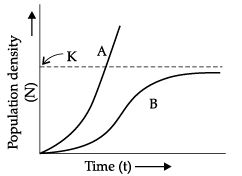Case Based Questions Test: Organisms & Populations - NEET MCQ
5 Questions MCQ Test Biology Class 12 - Case Based Questions Test: Organisms & Populations
Read the following text and answer the following question on the basis of the same:
Growth of a population with time shows specific and predictable patterns. Two types of growth pattern of population are exponential and logistic growth. When resources in the habitat are unlimited each species has the ability to realize fully its innate potential to grow in number. Then the population grows in exponential fashion. When the resources are limited the growth curve shows an initial slow rate and then it accelerates and finally slows giving the growth curve which is sigmoid.
Q. Identify the incorrect statement:
Read the following text and answer the following question on the basis of the same:
Growth of a population with time shows specific and predictable patterns. Two types of growth pattern of population are exponential and logistic growth. When resources in the habitat are unlimited each species has the ability to realize fully its innate potential to grow in number. Then the population grows in exponential fashion. When the resources are limited the growth curve shows an initial slow rate and then it accelerates and finally slows giving the growth curve which is sigmoid.
Q. The population growth is generally described by the following equation:
dN/dt = rN(K-N)/K
What does 'r' represent in the given equation?
Read the following text and answer the following question on the basis of the same:
Growth of a population with time shows specific and predictable patterns. Two types of growth pattern of population are exponential and logistic growth. When resources in the habitat are unlimited each species has the ability to realize fully its innate potential to grow in number. Then the population grows in exponential fashion. When the resources are limited the growth curve shows an initial slow rate and then it accelerates and finally slows giving the growth curve which is sigmoid.
Q. Identify the correct equation that represents the exponential population growth curve:
Read the following text and answer the following question on the basis of the same:
Growth of a population with time shows specific and predictable patterns. Two types of growth pattern of population are exponential and logistic growth. When resources in the habitat are unlimited each species has the ability to realize fully its innate potential to grow in number. Then the population grows in exponential fashion. When the resources are limited the growth curve shows an initial slow rate and then it accelerates and finally slows giving the growth curve which is sigmoid.
Q. Study the population growth curves (A and B) in the given graph and select the incorrect statement:

Read the following text and answer the following question on the basis of the same:
Growth of a population with time shows specific and predictable patterns. Two types of growth pattern of population are exponential and logistic growth. When resources in the habitat are unlimited each species has the ability to realize fully its innate potential to grow in number. Then the population grows in exponential fashion. When the resources are limited the growth curve shows an initial slow rate and then it accelerates and finally slows giving the growth curve which is sigmoid.
Q. The equations correctly represents Verhulst-Pearl logistic growth is:
|
78 videos|277 docs|174 tests
|




















